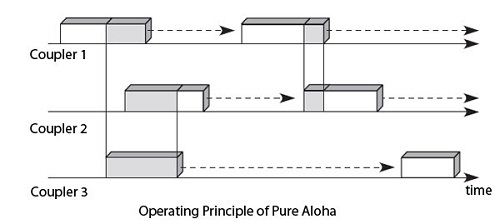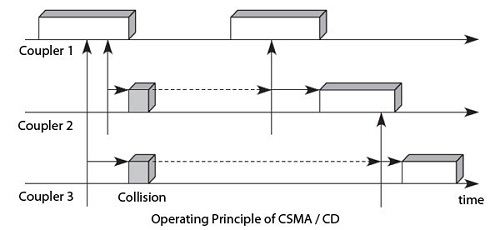Random Access, which is to issue a completely random time, relies on the Aloha method. The latter takes its name from an experiment performed on a network connecting the various islands of the Hawaiian Archipelago early 1970. In this method, when a coupler has information to transmit, it sends it without worry about other users. If there is a collision, that is to say superposition of two signals or more users, the signals become indecipherable and are lost. They are subsequently transmitted, as shown in Figure, in which the couplers 1, 2 and 3 collide. The coupler 1 transmits its field first because he shot the smallest timer. Then, the module 2 emits, and its signals collide with the coupler 1. Both derive a random time of retransmission. The coupler 3 is listening while the couplers 1 and 2 are silent, so that the frame of the coupler 3 passes successfully. Technical aloha is the origin of all the random access methods.
In addition to its extreme simplicity, aloha has the advantage of not requiring any synchronization and be completely decentralized. Its main drawback is the loss of information resulting from a collision and its lack of efficiency, since the transmission of colliding frames is not interrupted.
The flow rate of such a system becomes very small when the number of couplers increases. It can be shown mathematically that if the number of stations goes to infinity, the flow becomes zero. From a certain moment, the system is more stable. To reduce the likelihood of conflict between users, various improvements of this technique have been proposed.

Slotted aloha, aloha or sliced
Improved technical aloha was to cut the time into time slots, or slots, and to authorize the issuance of frames that slice first, the transmission time of a frame requiring exactly a slice of time. In this way, there is no collision if a single frame transmitted at the beginning of slice. However, if several frames start transmitting in the beginning of slice, the frames emissions are superimposed along the slot. In the latter case, there has retransmission after a random time.
This method improves the throughput during the start-up period but remains unstable. In addition, there is an additional cost from a complication of the devices, since all emissions must be synchronized.
CSMA, or listen with random access carrier
Technical CSMA (Carrier Sense Multiple Access) is to listen to the channel before transmitting. If the module detects a signal on the line, it differs his show at a later date. This significantly reduces the risk of collision, but does not eliminate them completely. If during the propagation time between the couple of the more remote stations (vulnerability period), a coupler does not detect the transmission of a frame, and there may be signal superposition. Therefore, it is necessary to subsequently retransmit lost frames.
Numerous variations of this technique have been proposed, which differ by three Features:
• The strategy followed by the module after detecting the channel status.
• The way collisions are detected.
• The message retransmission after collision policy.
Its main variants are:
• Non-persistent CSMA. The coupler the listening channel when a frame is ready to be sent. If the channel is free, the module emits. Otherwise, it starts the same process after a random delay.
• Persistent CSMA – A loan coupler to transmit the channel and previously listening forwards if it is free. If it detects the occupation of carrier, it continues to listen until the channel is clear and transmits at that time. This technique allows lose less time than in the previous case, but it has the disadvantage increase the likelihood of collision, since the frames that accumulate during the busy time are all transmitted simultaneously.
• P-persistent CSMA – The algorithm is the same as before, but when the
Channel becomes free; the module transmits with probability p. In other words, the coupler differs his show with probability 1 – p. This algorithm reduces the likelihood of collision. Assuming both terminals simply making the collision is inevitable in the standard case. With the new algorithm, there is a probability 1 – p that each terminal does not transmit, thereby avoiding the collision. However, it increases the time before transmission, since a terminal may choose not to transmit, with a probability 1 – p, while the channel is free.
• CSMA / CD (Carrier Sense Multiple Access / Collision Detection) – This technique normalized random access by the IEEE 802.3 working group is currently the longer used. At a preliminary listening to the network is added listening during transmission. Coupler to issue a loan that detected free channel transmits and continues to listen the channel. The coupler continues to listen, which is sometimes indicated by the CSMA / CD persistent acronym. If there is a collision, it interrupts its transmission as soon as possible and sends special signals, called padding bits so that all couplers are notified of the collision. He tries again his show later using an algorithm that we present later.
Figure shows the CSMA/CD. In this example, the couplers 2 and 3 attempt broadcasting for the coupler 1 transmits its own frame. The couplers 2 and 3 begin to listen and transmit at the same time, the propagation delay around, from the end of the Ethernet frame transmitted by the coupler 1. A collision ensues. Like the couplers 2 and 3 continue to listen to the physical media, they realize the collision, stop their transmission and draw a random time to start retransmission process.

The CSMA/CD create an efficiency gain compared to other techniques random access because there are immediate collision detection and interruption of current transmission. Issuers couplers recognize a collision by comparing the transmitted signal with the passing on the line. The collisions are no longer recognized by absence of acknowledgment but by detecting interference. This conflict detection method is relatively simple, but it requires sufficient performance coding techniques to easily recognize a superposition signal. It is generally used for this differential coding technique, such as differential Manchester code.
• CSMA / CA – Less known than the CSMA / CD access CSMA / CA (Carrier Sense Multiple Access / Collision Avoidance) starts to be heavily used in Wi-Fi networks, that is to say, the wireless Ethernet IEEE 802.11. This is a variation of the CSMA / CD, which allows the CSMA method run when collision detection is not possible, as in the radio. Its operating principle is to resolve contention before the data are transmitted using acknowledgments and timers.
The couplers are testing wishing to transmit the channel several times to ensure that no activity is detected. Every message received shall be immediately paid by the receiver. Sending new messages takes place only after a certain period, so as to ensure a transport without loss of information. The non-return of an acknowledgment, after a predetermined time interval, to detect if there was a collision. This strategy not only makes it possible to implement an acknowledgment mechanism in frame but has the advantage of being simple and economic, since it does not require collision detection circuit, unlike the CSMA/ CD.
There are various techniques of CSMA with collision resolution, including the CSMA / CR (Carrier Sense Multiple Access / Collision Resolution). Some variants use the CSMA also priority mechanisms that may come under this term, that avoid collisions by separate priority levels associated with different stations connected to the network.
 Dinesh Thakur holds an B.C.A, MCDBA, MCSD certifications. Dinesh authors the hugely popular
Dinesh Thakur holds an B.C.A, MCDBA, MCSD certifications. Dinesh authors the hugely popular